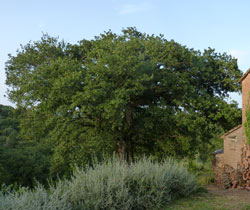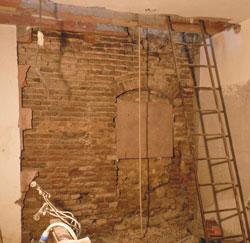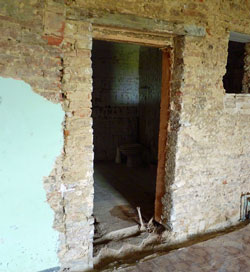|
Our big oak is magnificent. We’ve always known that, but now we know it more. The elms – then more recently Dutch-elm-disease-ravaged skeletons – that hemmed it in have been removed. |
|
|
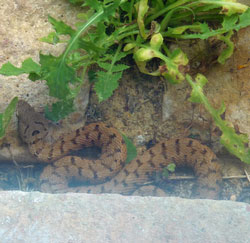 |
||
Each summer brings its snake episodes and this year I had two in the space of two days (over and above, of course, the postbox snake).
I suddenly got it into my head, early one morning when we had guests staying, to make scones for breakfast; but so as not to heat up the house too much (this was before the big storm three weeks ago which cooled down our scorching air, only for temps to rise again) I opened the back door wide, and remembered to prop up the 30cm-high piece of plyboard which I wedge into the doorframe to keep out crawly things and the less intelligent/agile scurrying lizards.
I harbour few illusions about this line of defence: I know most things could get over it if they were really determined. But it sets my mind at rest.
When the scones were ready and the oven off, I went to shut the door but as I bent down to remove the plyboard, I found a grass snake – a lustrous black, flecked regularly with greeny-gold – lounging up against it, sunning itself. Its tail was off towards my office. Its head, I couldn’t see: it must have been somewhere around the stairs on the other side. The door is 1m20 wide. This beast must have been well over 1m50. Thank goodness he didn’t take it into his head to slither over my defensive wall.
The following day, I walked through the front door then thought: what was that on the front step? I opened the door a crack then slammed it shut, sweating. There was a little viper, neatly coiled on the theshold.
Now, I don’t like snakes of any variety, but at least my common sense tells me that grass snakes (a) don’t kill you and (b) run away. Vipers (a) do and (b) don’t. What’s more, they’re very territorial and if a viper decides your front step is his home, it’s his home.
Much as we both hate killing things, we couldn’t see much alternative. L rushed around the house to grab a spade, and dropped it on the poor animal. But to kill a snake you need to get its head, and this angry thrashing poisonous thing was now pinned ineffectively to the earthy bit between the bricks of the front path. L had to keep it there. While I sped around to grab another spade (and put on the longest thickest rubber boots I could find) and finish it off. I trembled for about an hour afterwards.
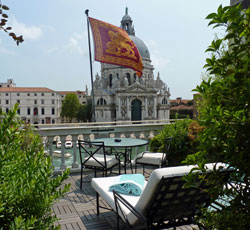 |
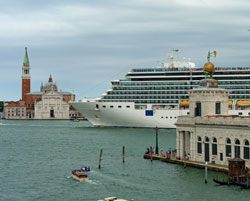 |
|||
 |
||||
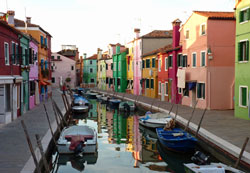 |
||||
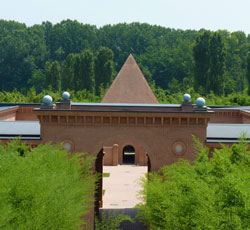 |
||||
 |
||||
Earlier this month, on a very quick dash to Venice, we spent a night on Burano (and another in a rather fantastic room-with-a-view at the Europa & Regina right on the Grand Canal – a panorama temporarily rendered dramatic and depressing by the Sunday evening parade of departing cruise ships).
Crazy-coloured Burano is the kind of place we avoid in anything like high season: a seething den of hot and tetchy tourists, snapping up ‘real’ Burano lace produced in sweat shops on the other side of the globe. So staying here – in Venissa’s brand new suites – was a revelation. It’s a jolly, buzzy place when the visiting hordes have gone. Yes, there are boarded up houses and ‘for sale’ signs a-plenty. But there are also cafés with locals catching up – probably after hiding for the rest of the day. And the quirky little gardens with their odd outsider-art-ish pebble, shell and tacky statue arrangements are certainly not there by order of the tourist board.
On the train crossing from the mainland to Venice proper, there was a French family next to me – slightly older parents (or were they grandparents?) and a child of about nine or ten.
“Wow!” said the little boy as Venice hove into sight. “C’est comme les Hawaii!” I’m still racking my brains for similarities between the two.
In a pleasant little B&B I took a look at in the northern Santa Croce area of Venice, I noticed two serious bicycles parked in the courtyard. Not only are bicycles absolutely useless in a city without roads and with endless bridges to cross, they’re also illegal. I asked the B&B owner what they were doing there, and she shrugged.
“They’re Brits. They didn’t realise they couldn’t ride around the city. It happens quite often.
Our winding route home took us to the Labirinto di Masone in Fontanellato near Parma, the folly of publisher Franco Maria Ricci. We had lunch with Ricci and his wife in their extraordinary house next door – an end-of-empire feeling place, both for Ricci’s advanced years and poor state of health, and because the whole place, swathed in his beloved bamboo, felt more Indian jungle lodge than Emilia Romagna wealthy bolthole.
His bamboo obsession extends to the massive maze, which, yes, includes many varieties but only an expert would recognise this. For the layman it all looks kind of same-y. No one expects a maze to be variegated, of course, but the bamboo here is so tall and frondy that at times all sense of perspective is gone. You lose sight of the fact that you’re in a maze at all: you could simply be wandering along a very eccentric garden path.
At the heart of the complex is a forbidding pyramid, a red-brick temple to who-knows-what. I sound disapproving. And perhaps, in some ways I am. But in fact the dedication to making a dream come true, and the passion obvious in the adjoining art collection – beautifully hung however you feel about the works on show – are infectious.
At a wedding party last week, our wonderful neighbour Maria – the one who never married because she couldn’t find a man who could repair a tractor as well as she does –was looking incredibly smart, in bright red platform heels which made her slightly taller than her usual height of half way between my elbow and my shoulder. She was wearing the shiniest imaginable gold necklace.
“Two ladies whom I looked after when they were old and ill left me some money,” she told me. “I didn’t need it, so I went and bought a gold necklace that cost the amount they left me.”
It’s strange that Maria would have thought of a necklace. She’s definitely not a jewellery type. It was pretty in its way, but I suspect it was the gold rather than the aesthetics that mattered to her: an investment, not a fashion statement.
“This is the first time I’ve ever worn it.” She had told me the value in lire, so she must have purchased it before 2002. “And I’m going to tell you where I keep it because if I die, I don’t want them to throw it away by accident.”
Maria being one of the most remarkably full-of-life people I know, and only ten years (and one day) older than I am, I really don’t think she’s about to leave us any time soon, as I pointed out to her. But she was having none of that. “It could happen any day.” All right Maria, anything you say.
I’d love to think that this was a sudden outpouring of confidence in me, a need to share her deepest secrets with a treasured neighbour. But I suspect she has told her big secret to most of town: that would be very like ever-trusting Maria, to whom everyone is a treasure (with the exception of her ghastly brother who has brought her lovely agriturismo business to a halt with his grasping manoeuvrings). The funny thing is though, that I’m quite sure everyone she has told will defend her property staunchly. Maria’s the kind of honest contadina who inspires absolute loyalty.
